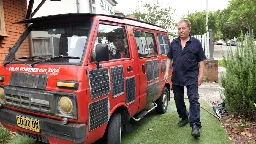Ziga's van runs on solar panels, three lawn mower motors and 8,000 laptop and power tool batteries
Ziga's van runs on solar panels, three lawn mower motors and 8,000 laptop and power tool batteries

www.abc.net.au
Ziga's van runs on solar panels, three lawn mower motors and 8,000 laptop and power tool batteries

Thought of you fine folks when I came across this article on aussie.zone
